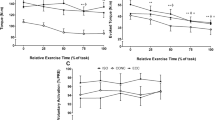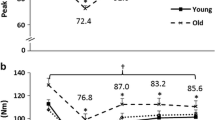Abstract
Introduction
Following active lengthening or shortening contractions, isometric steady-state torque is increased (residual force enhancement; rFE) or decreased (residual force depression; rFD), respectively, compared to fixed-end isometric contractions at the same muscle length and level of activation. Though the mechanisms underlying this history dependence of force have been investigated extensively, little is known about the influence of exercise-induced muscle weakness on rFE and rFD.
Purpose
Assess rFE and rFD in the dorsiflexors at 20%, 60%, and 100% maximal voluntary torque (MVC) and activation matching, and electrically stimulated at 20% MVC, prior to, 1 h following, and 24 h following 150 maximal eccentric dorsiflexion contractions.
Methods
Twenty-six participants (13 male, 24.7 ± 2.0y; 13 female, 22.5 ± 3.6y) were seated in a dynamometer with their right hip and knee angle set to 110° and 140°, respectively, with an ankle excursion set between 0° and 40° plantar flexion (PF). MVC torque, peak twitch torque, and prolonged low frequency force depression were used to assess eccentric exercise-induced neuromuscular impairments. History-dependent contractions consisted of a 1 s isometric (40°PF or 0°PF) phase, a 1 s shortening or lengthening phase (40°/s), and an 8 s isometric (0°PF or 40°PF) phase.
Results
Following eccentric exercise; MVC torque was decreased, prolonged low frequency force depression was present, and both rFE and rFD increased for all maximal and submaximal conditions.
Conclusions
The history dependence of force during voluntary torque and activation matching, and electrically stimulated contractions is amplified following eccentric exercise. It appears that a weakened neuromuscular system amplifies the magnitude of the history-dependence of force.







Similar content being viewed by others
Data availability
The data set generated and analysed during the current study are available from the corresponding author on reasonable request.
Abbreviations
- MVC:
-
Maximal voluntary contraction
- EMG:
-
Electromyography
- iEMG:
-
Integral electromyography
- EMGRMS :
-
Root mean square electromyography
- rFERel :
-
Relative residual force enhancement
- rFEAbs :
-
Absolute residual force enhancement
- AR:
-
Activation reduction
- rFD:
-
Residual force depression
- AI:
-
Activation increase
- ANOVA:
-
Analysis of variance
- PF:
-
Plantar Flexion
- M-Max:
-
Maximum compound muscle action potential
References
Abbott BC, Aubert XM (1952) The force exerted by active striated muscle during and after change of length. J Physiol 117:77–86
Altenburg TM, de Ruiter CJ, Verdijk PW, van Mechelen W, de Haan A (2008) Vastus lateralis surface and single motor unit EMG following submaximal shortening and lengthening contractions. Appl Physiol Nutr Metab 33:1086–1095
Altenburg TM, de Ruiter CJ, Verdijk PW, van Mechelen W, de Haan A (2009) Vastus lateralis surface and single motor unit electromyography during shortening, lengthening and isometric contractions corrected for mode-dependent differences in force-generating capacity. Acta Physiol (oxf) 196:315–328
Brown LM, Hill L (1991) Some observations on variations in filament overlap in tetanized muscle fibres and fibres stretched during a tetanus, detected in the electron microscope after rapid fixation. J Muscle Res Cell Motil 12:171–182
Bruce CD, Ruggiero L, Dix GU, Cotton PD, McNeil CJ (2021) Females and males do not differ for fatigability, muscle damage and magnitude of the repeated bout effect following maximal eccentric contractions. Appl Physiol Nutr Metab 46:238–246
Bruton JD, Place N, Yamada T, Silva JP, Andrade FH, Dahlstedt AJ, Zhang SJ, Katz A, Larsson NG, Westerblad H (2008) Reactive oxygen species and fatigue-induced prolonged low-frequency force depression in skeletal muscle fibres of rats, mice and SOD2 overexpressing mice. J Physiol 586:175–184
Chapman N, Whitting J, Broadbent S, Crowley-McHattan Z, Meir R (2018) Residual Force Enhancement in Humans: A Systematic Review. J Appl Biomech 34:240–248
Chen J, Power GA (2019) Modifiability of the history dependence of force through chronic eccentric and concentric biased resistance training. J Appl Physiol 126:647–657
Chen J, Hahn D, Power GA (2019) Shortening-induced residual force depression in humans. J Appl Physiol 126:1066–1073
Chen J, Mashouri P, Fontyn S, Valvano M, Elliott-Mohamed S, Noonan AM, Brown SHM, Power GA (2020) The influence of training-induced sarcomerogenesis on the history dependence of force. J Exp Biol 223:jeb218776
Contento VS, Dalton BH, Power GA (2019) The inhibitory tendon-evoked reflex is increased in the torque-enhanced state following active lengthening compared to a purely isometric contraction. Brain Sci 10:13
Dalton BH, Contento VS, Power GA (2018) Residual force enhancement during submaximal and maximal effort contractions of the plantar flexors across knee angle. J Biomech 78:70–76
Dargeviciute G, Masiulis N, Kamandulis S, Skurvydas A, Westerblad H (2013) Residual force depression following muscle shortening is exaggerated by prior eccentric drop jump exercise. J Appl Physiol 115:1191–1195
Duchateau J, Enoka RM (2016) Neural control of lengthening contractions. J Exp Biol 219:197–204
Fortuna R, Kirchhuebel H, Seiberl W, Power GA, Herzog W (2018) Force depression following a stretch-shortening cycle is independent of stretch peak force and work performed during shortening. Sci Rep 8:1534
Friden J, Sjostrom M, Ekblom B (1981) A morphological study of delayed muscle soreness. Experientia 37:506–507
Fukutani A, Herzog W (2018) Residual Force Enhancement Is Preserved for Conditions of Reduced Contractile Force. Med Sci Sports Exerc 50:1186–1191
Fukutani A, Herzog W (2019) Current understanding of residual force enhancement: cross-bridge component and non-cross-bridge component. Int J Mol Sci 20:5479
Herzog W (2004) History dependence of skeletal muscle force production: implications for movement control. Hum Mov Sci 23:591–604
Herzog W (2018) The multiple roles of titin in muscle contraction and force production. Biophys Rev 10:1187–1199
Herzog W, Leonard TR, Wu JZ (2000) The relationship between force depression following shortening and mechanical work in skeletal muscle. J Biomech 33:659–668
Hinks A, Davidson B, Akagi R, Power GA (2021a) Influence of isometric training at short and long muscle-tendon unit lengths on the history dependence of force. Scand J Med Sci Sports 31:325–338
Hinks A, Hess A, Debenham MIB, Chen J, Mazara N, Inkol KA, Cervone DT, Spriet LL, Dalton BH, Power GA (2021b) The torque-frequency relationship is impaired similarly following two bouts of eccentric exercise: No evidence of a protective repeated bout effect. J Biomech 122:110448
Jakobi JM, Kuzyk SL, McNeil CJ, Dalton BH, Power GA (2020) Motor unit contributions to activation reduction and torque steadiness following active lengthening: a study of residual torque enhancement. J Neurophysiol 123:2209–2216
Jones AA, Power GA, Herzog W (2016) History dependence of the electromyogram: Implications for isometric steady-state EMG parameters following a lengthening or shortening contraction. J Electromyogr Kinesiol 27:30–38
Joumaa V, Herzog W (2010) Force depression in single myofibrils. J Appl Physiol 108:356–362
Joumaa V, Leonard TR, Herzog W (2008) Residual force enhancement in myofibrils and sarcomeres. Proc Biol Sci 275:1411–1419
Joumaa V, Power GA, Hisey B, Caicedo A, Stutz J, Herzog W (2015) Effects of fiber type on force depression after active shortening in skeletal muscle. J Biomech 48:1687–1692
Joumaa V, Smith IC, Fukutani A, Leonard TR, Ma W, Mijailovich SM, Irving TC, Herzog W (2021) Effect of Active Lengthening and Shortening on Small-Angle X-ray Reflections in Skinned Skeletal Muscle Fibres. Int J Mol Sci 22:8526
Lee HD, Herzog W (2002) Force enhancement following muscle stretch of electrically stimulated and voluntarily activated human adductor pollicis. J Physiol 545:321–330
Lee HD, Herzog W (2003) Force depression following muscle shortening of voluntarily activated and electrically stimulated human adductor pollicis. J Physiol 551:993–1003
Mashouri P, Chen J, Noonan AM, Brown SHM, Power GA (2021) Modifiability of residual force depression in single muscle fibers following uphill and downhill training in rats. Physiol Rep 9:e14725
Oskouei AE, Herzog W (2005) Observations on force enhancement in submaximal voluntary contractions of human adductor pollicis muscle. J Appl Physiol 98:2087–2095
Oskouei AE, Herzog W (2006a) The dependence of force enhancement on activation in human adductor pollicis. Eur J Appl Physiol 98:22–29
Oskouei AE, Herzog W (2006b) Force enhancement at different levels of voluntary contraction in human adductor pollicis. Eur J Appl Physiol 97:280–287
Paquin J, Power GA (2018) History dependence of the EMG-torque relationship. J Electromyogr Kinesiol 41:109–115
Pinniger GJ, Cresswell AG (2007) Residual force enhancement after lengthening is present during submaximal plantar flexion and dorsiflexion actions in humans. J Appl Physiol 102:18–25
Power GA, Dalton BH, Rice CL, Vandervoort AA (2010) Delayed recovery of velocity-dependent power loss following eccentric actions of the ankle dorsiflexors. J Appl Physiol 109:669–676
Power GA, Dalton BH, Rice CL, Vandervoort AA (2011) Reproducibility of velocity-dependent power: before and after lengthening contractions. Appl Physiol Nutr Metab 36:626–633
Power GA, Rice CL, Vandervoort AA (2012a) Increased residual force enhancement in older adults is associated with a maintenance of eccentric strength. PLoS ONE 7:e48044
Power GA, Rice CL, Vandervoort AA (2012b) Residual force enhancement following eccentric induced muscle damage. J Biomech 45:1835–1841
Power GA, Dalton BH, Rice CL, Vandervoort AA (2013a) Peak power is reduced following lengthening contractions despite a maintenance of shortening velocity. Appl Physiol Nutr Metab 38:1196–1205
Power GA, Makrakos DP, Stevens DE, Rice CL, Vandervoort AA (2013b) Enhanced force production in old age is not a far stretch: an investigation of residual force enhancement and muscle architecture. Physiol Rep 1:e00004
Power GA, Herzog W, Rice CL (2014a) Decay of force transients following active stretch is slower in older than young men: support for a structural mechanism contributing to residual force enhancement in old age. J Biomech 47:3423–3427
Power GA, Makrakos DP, Stevens DE, Herzog W, Rice CL, Vandervoort AA (2014b) Shortening-induced torque depression in old men: implications for age-related power loss. Exp Gerontol 57:75–80
Power GA, Hinks A, Mashouri P, Contento VS, Chen J (2020) The long and short of residual force enhancement non-responders. Eur J Appl Physiol 120:2565–2567
Proske U, Morgan DL (2001) Muscle damage from eccentric exercise: mechanism, mechanical signs, adaptation and clinical applications. J Physiol 537:333–345
Raiteri BJ, Hahn D (2019) A reduction in compliance or activation level reduces residual force depression in human tibialis anterior. Acta Physiol (oxf) 225:e13198
Ramsey KA, Bakker AJ, Pinniger GJ (2010) Fiber-type dependence of stretch-induced force enhancement in rat skeletal muscle. Muscle Nerve 42:769–777
Roeleveld K, Stegeman DF, Vingerhoets HM, Van Oosterom A (1997) Motor unit potential contribution to surface electromyography. Acta Physiol Scand 160:175–183
Seiberl W, Power GA, Hahn D (2015) Residual force enhancement in humans: Current evidence and unresolved issues. J Electromyogr Kinesiol 25:571–580
Semmler JG (2014) Motor unit activity after eccentric exercise and muscle damage in humans. Acta Physiol (oxf) 210:754–767
Siebert T, Kurch D, Blickhan R, Stutzig N (2016) Does weightlifting increase residual force enhancement? J Biomech 49:2047–2052
Smith CB, Cheng AJ, Rice CL (2011) Potentiation of the triceps brachii during voluntary submaximal contractions. Muscle Nerve 43:859–865
Sypkes CT, Kozlowski B, Grant J, Bent LR, McNeil CJ, Power GA (2017) Spinal excitability is increased in the torque-depressed isometric steady state following active muscle shortening. R Soc Open Sci 4:171101
Sypkes CT, Kozlowski BJ, Grant J, Bent LR, McNeil CJ, Power GA (2018) The influence of residual force enhancement on spinal and supraspinal excitability. PeerJ 6:e5421
Sypkes CT, Contento VS, Bent LR, McNeil CJ, Power GA (2019) Central contributions to torque depression: an antagonist perspective. Exp Brain Res 237:443–452
Sypkes CT, Dalton BH, Stuart J, Power GA (2020) Inhibitory tendon-evoked reflex is attenuated in the torque-depressed isometric steady-state following active shortening. Appl Physiol Nutr Metab 45:601–605
Talbot JA, Morgan DL (1996) Quantitative analysis of sarcomere non-uniformities in active muscle following a stretch. J Muscle Res Cell Motil 17:261–268
Tilp M, Steib S, Herzog W (2009) Force-time history effects in voluntary contractions of human tibialis anterior. Eur J Appl Physiol 106:159–166
Tomalka A, Weidner S, Hahn D, Seiberl W, Siebert T (2020) Cross-bridges and sarcomeric non-cross-bridge structures contribute to increased work in stretch-shortening cycles. Front Physiol 11:921
Acknowledgements
Infrastructure was provided by the University of Guelph start-up funding. We would like to thank all participants of this study. We would also like to thank Avery Hinks for constructive edits and feedback on an earlier version of this manuscript.
Funding
This project was supported by the Natural Sciences and Engineering Research Council of Canada (NSERC).
Author information
Authors and Affiliations
Contributions
Conceptualization, V.S.C., and G.A.P.; data curation, V.S.C.; formal analysis, V.S.C. and G.A.P.; funding acquisition, G.A.P.; investigation, V.S.C. and G.A.P.; methodology, V.S.C., and G.A.P.; supervision, G.A.P.; writing—original draft, V.S.C., and G.A.P.; writing—review and editing, V.S.C., and G.A.P. All authors have read and agreed to the published version of the manuscript.
Corresponding author
Ethics declarations
Conflict of interest
The authors declare that they have no competing interests.
Ethical statement
All procedures were approved by the Research Ethics Board Committee of the University of Guelph [REB#:20-09-026].
Additional information
Communicated by Philip D. Chilibeck.
Publisher's Note
Springer Nature remains neutral with regard to jurisdictional claims in published maps and institutional affiliations.
Rights and permissions
Springer Nature or its licensor (e.g. a society or other partner) holds exclusive rights to this article under a publishing agreement with the author(s) or other rightsholder(s); author self-archiving of the accepted manuscript version of this article is solely governed by the terms of such publishing agreement and applicable law.
About this article
Cite this article
Contento, V.S., Power, G.A. Eccentric exercise-induced muscle weakness amplifies the history dependence of force. Eur J Appl Physiol 123, 749–767 (2023). https://doi.org/10.1007/s00421-022-05105-z
Received:
Accepted:
Published:
Issue Date:
DOI: https://doi.org/10.1007/s00421-022-05105-z




